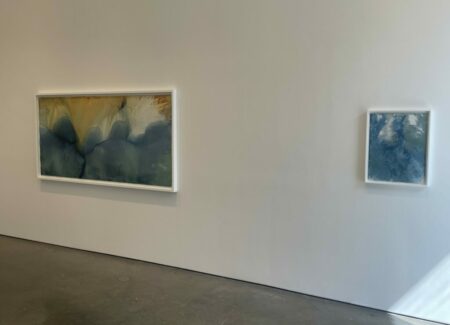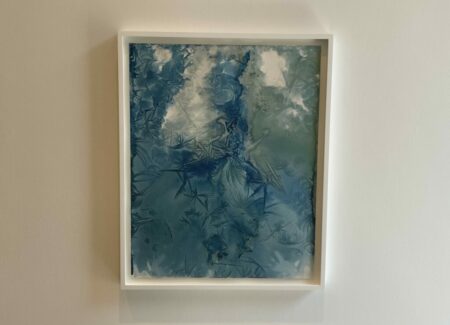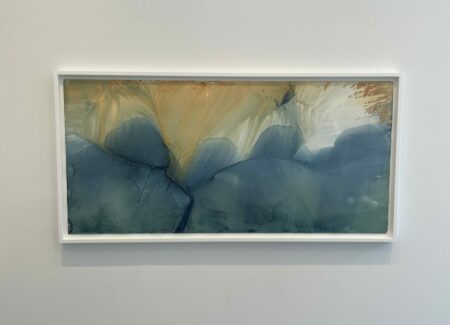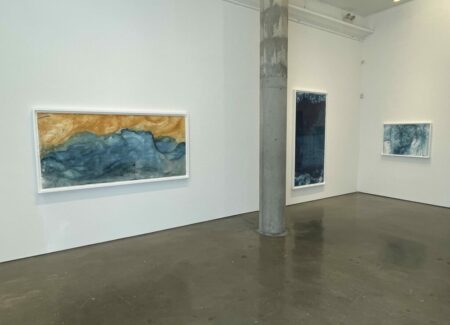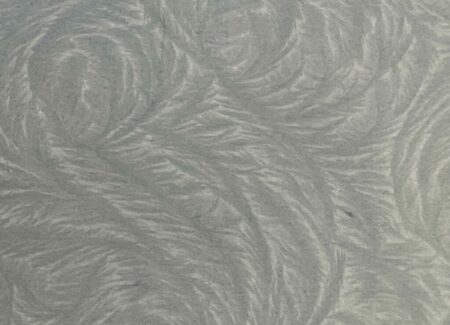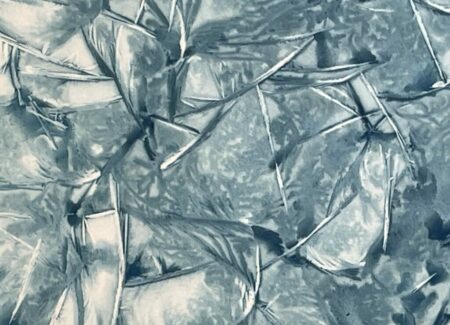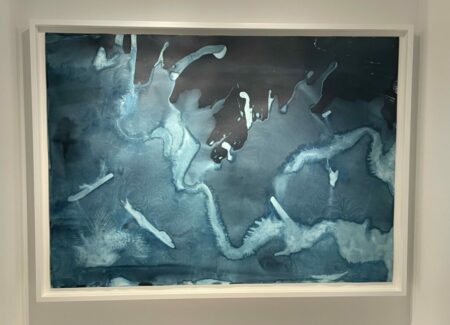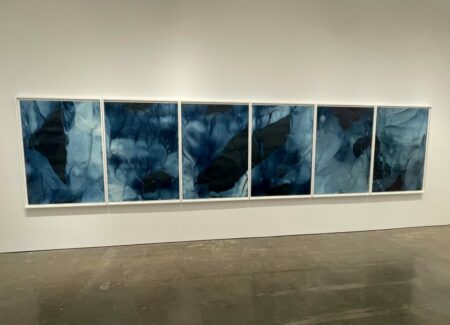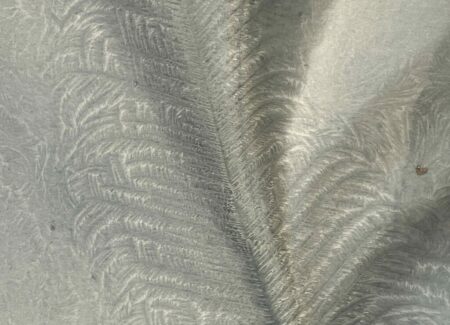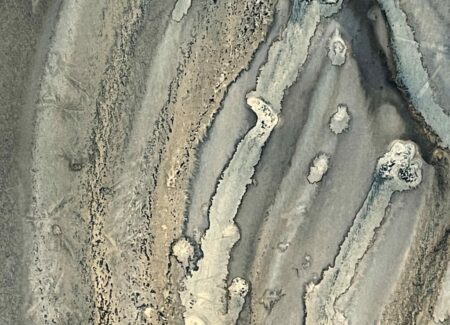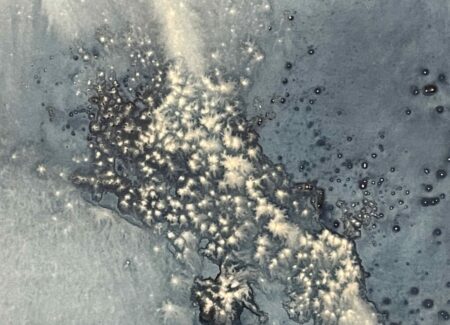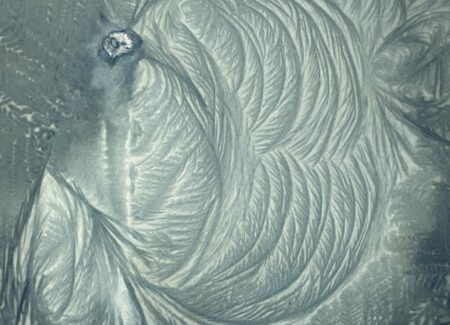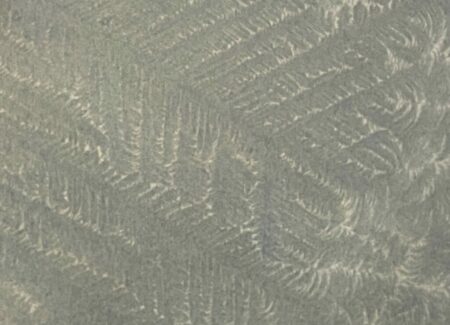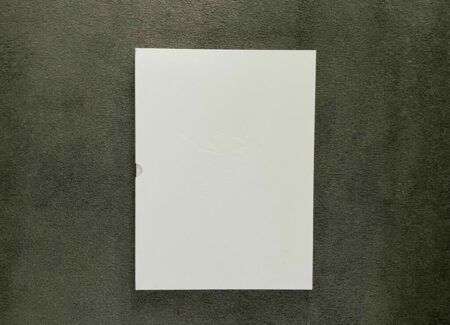JTF (just the facts): A total of 11 photographic works, framed in white and unmatted, and hung against white walls in the East and West gallery spaces and the Jewel Box in the connecting hallway.
The following works are included in the show:
- 7 dynamic cyanotypes, 2020, 2021-2022, 2022, sized roughly 24×19, 30×42, 42×88, or 88×42 inches, unique
- 1 dynamic cyanotype in 2 parts, 2020, each panel sized roughly 60×42 inches, unique
- 2 dynamic cyanotypes in 3 parts, 2021, 2022, each panel sized roughly 60×42 inches, unique
- 1 set of 6 dynamic cyanotypes, 2020, each panel sized roughly 60×42 inches, unique
A monograph of this body of work has recently been c0-published by the gallery and Radius Books (here). Hardcover with slipcase, 11.5×13.25 inches, 120 pages, with 64 color images. Includes an essay by Rebecca Solnit. (Cover shot below.)
Comments/Context: For much of the past decade, Meghann Riepenhoff has been methodically following a unique photographic path, allowing the natural properties of water to be her guide. At the center of her practice lies the physical, camera-less cyanotype process, and water (in its countless forms) has been her consistent subject. She has made images in streams, ponds, springs, rivers, and oceans around the world; she has documented the flows of rain, currents, waves, and rougher splashes; she has worked in extremes of heat and cold; and she has explored the in-between edge systems of rocky shorelines, sandy beaches, and dirty runoffs. In short, she has immersed herself in the nearly infinite nuances of her chosen subject (and its intimate relationship to her artistic process), patiently teasing out its hidden subtleties and collaborative possibilities.
Water in its frozen form of ice first started appearing in Riepenhoff’s work in her last gallery show (in 2019, reviewed here), and in the subsequent years, she has turned the complexities of freezing and ice into a discrete project. The main difference between these new works and what came before is the nature of the fluidity that is captured in her images; what was once loose motion across space and time (often in washed layers or relentless torrents) has now slowed down to the point where the water stops and crystallizes, the state change introducing intricate crystal patterns.
As we know from Wilson Bentley’s late 19th century photographs of snowflakes, the visual variety to be found in water crystallization is often astonishing. Depending on the water conditions (temperature, thickness, salinity, etc.), the crystals form differently, and Riepenhoff’s images capture an ephemeral slice of that engrossing scientific diversity. An up close inspection of Riepenhoff’s ice compositions is something like a textural treasure hunt, with feathery wisps, rigid geometric patterns, sparkling clumps, drifted lines, and swirling fractals emerging out of the watery depths, with each composition offering something unique.
Science and art intermingle in serendipitous ways in these images, with the intentional alignment of the paper with the freezing water and the land underneath, as well as the duration of the exposure influencing the development of the chance effects of the ice formation; these are not simply deadpan documents of scientific principles at work, but expressive interpretations of those processes, where the idea of artistic control is relative but still being exerted.
Time is another variable worth pondering when looking closely at these pictures – it slows and then stops before our eyes, and perhaps even restarts, depending on the cycle of freeze and melt taking place and the length of the various periods. This leads to areas of crisp detail and softer ambiguity, with sharp crystals giving way to fluid movement, like a crack becoming a drip becoming a stream or a wash. In most of the images, watery fluidity meets hardened ice formation, with the interchange creating intriguing zones of uncertainty and contrasts of surface.
For those who have particular expectations for what the very specific blue of a cyanotype looks like (perhaps the deep clear Prussian blue of Anna Atkins), Riepenhoff’s images will create a sense of glorious confusion. Yes, there is of course blue, but that blue wanders from near white to near black, with detours into zones of yellow, orange, green, beige, and brown, with specks of dirt and salt thrown in for good measure, essentially allowing the reactions of the chemicals to the idiosyncrasies of the local environment to generate a broad palette of natural colors. For those who revel in blues, the works majestically wander and shift through a spectrum of lights and darks, trading deep inky richness for ghostly thinness again and again, only to be interrupted by the sharp scratchiness and gestural mark making of the crystal forms. That such tonal range could be coaxed out such an elementary process (without tinting or other external additions) is a testament to Riepenhoff’s experimental persistence, and of course, nature’s gifts for those who take the time to look for them.
A few of the works included in the show expand out from one single frame to multiple panels, creating scale along two different conceptual paths. In several cases, Riepenhoff has physically aligned two or three panels horizontally along a stretch of shoreline, creating a wider experience of a discrete moment, when the panels are hung side by side; in one other case, Riepenhoff made six different exposures at the same exact river location, so when the panels are hung together, we have a stuttering flip book effect, where the same space is seen again and again with alternate washes of freezing water. In both approaches, when more panels are added, the muscularity of the works increases, filling more wall space and offering more enveloping and immersive visual fields to explore.
With each successive project, Riepenhoff is further coming to grips with an artistic process that is overtly collaborative with nature, where in a sense, both sides are improvising simultaneously, creating works that incorporate contributions from both artist and subject. The Ice works add in the engaging crystallization effects, changing the overall artistic calculus of fluidity and stasis and generating some new mark making techniques, but the central ephemeral negotiation between artist and water is still the same. As the years pass and pictures pile up, it feels like Riepenhoff is wrestling with a partner who is unwilling to entirely give up her secrets; each project pries a few more clues and details loose, but the whole unruly spirit is still tantalizing elusive. Perhaps this what gives Riepenhoff’s best compositions their lasting interest – she’s captured a fleeting glimpse of something elemental and eternal, but never quite tamed the raw power that lies underneath.
Collector’s POV: The works in this show are priced between $10000 and $120000, based on size. Riepenhoff’s work has little secondary market history at this point, so gallery retail likely remains the best option for those collectors interested in following up.
